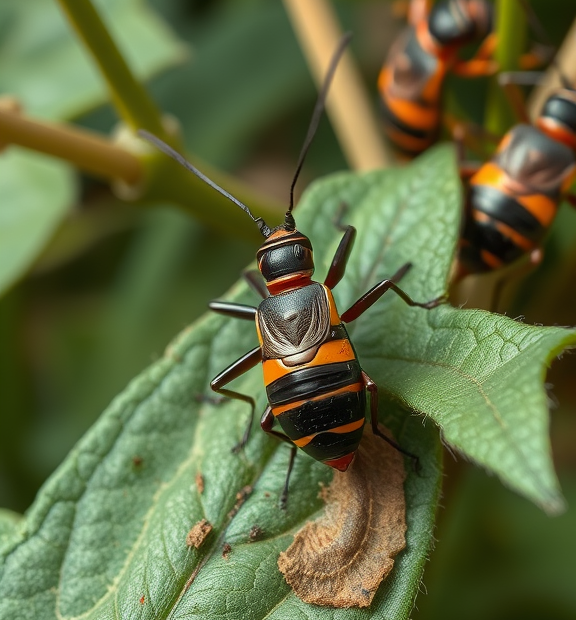Effective Methods for How to Get Rid of Earwigs in the Garden
Dealing with earwigs in your garden can be a frustrating experience. These little pests tend to sneak in at night, making them hard to catch. However, with some effective methods, you can learn how to get rid of earwigs and keep your garden thriving. Here are some proven strategies to help you tackle this issue.
First, it’s essential to understand why earwigs invade gardens. They are attracted to moist environments and decaying organic matter. Keeping your garden tidy and dry is a significant step in erasing their cozy home. Here are some actionable tips you can consider:
Maintain Cleanliness
Keeping your garden clean and free of debris is crucial. Here’s how you can do that:
- Remove any dead leaves, plant debris, or decayed wood.
- Clear your garden beds of mulch and reapply it only when dry.
- Regularly trim back overgrown plants that may provide cover for earwigs.
Use Traps
Setting traps can effectively capture earwigs. You can create simple traps using household items. Consider these options:
- Moist newspaper trap: Roll up a damp newspaper and place it in your garden. Earwigs will be attracted to the moisture and seek shelter inside the roll. You can check the trap in the morning and dispose of the trapped earwigs.
- Oil and water trap: Fill a shallow dish with water and add a few drops of vegetable oil. Place it at ground level in your garden. The earwigs will drown when they get too close.
Natural Repellents
Repelling earwigs without harmful chemicals is a smart move for your garden’s health. Try these natural repellents:
- Essential oils: Oils like peppermint, tea tree, or rosemary can repel earwigs. Mix a few drops of essential oil with water in a spray bottle and apply it to infested areas.
- Citrus peels: Earwigs dislike the scent of citrus. Scatter citrus peels around your garden. This not only helps deter earwigs but also adds nutrients to the soil as they decompose.
Adjust Watering Practices
Since earwigs thrive in moist conditions, altering how you water your garden can make a real difference. Here are a few tips:
- Water your plants in the morning instead of the evening to allow the soil to dry out overnight.
- Inspect your irrigation systems for leaks. Excessive water can create a conducive environment for earwigs.
- Use soaker hoses to direct water to the roots while keeping the top of the soil drier.
Introduce Beneficial Insects
Beneficial insects can be a great ally in controlling earwig populations. Some insect species prey on earwigs and can help keep their numbers in check. Consider introducing the following:
- Birds: Attract birds by setting up birdhouses or feeders. They love to snack on earwigs.
- Ladybugs: These bugs are known for their appetite for pests and can also help curb an earwig infestation.
Chemical Solutions
Love what I do? Be a hero and help me keep creating awesome content!
Support My Mission Now!Every donation fuels more great stuff – thank you, legend!
If natural methods do not work, you might need to consider chemical options. Use pesticides specifically designed for earwigs. Follow the instructions carefully, applying them at the right times to maximize effectiveness. However, use this as a last resort, as many chemical solutions can harm beneficial insects as well.
By implementing these strategies, you can effectively get rid of earwigs in your garden. A combination of cleanliness, trapping, natural repellents, and careful watering will not only reduce earwig populations but also promote a healthier garden environment. You’ll find that these simple changes can lead to a thriving garden free from unwanted pests.
Understanding the Role of Earwigs in the Ecosystem and Their Impact on Gardens
Love what I do? Be a hero and help me keep creating awesome content!
Support My Mission Now!Every donation fuels more great stuff – thank you, legend!
Earwigs are often misunderstood insects that play a unique role in the ecosystem, particularly in gardens. While many people find them unappealing due to their pincers, they actually provide several benefits. Understanding how they function can lead to a better appreciation of their presence as well as informed decisions about managing them in your garden.
One of the primary roles of earwigs is as scavengers. They consume decaying plant matter, organic debris, and dead insects. This helps to recycle nutrients back into the soil, which can improve its overall quality and promote healthy plant growth. By breaking down these materials, earwigs contribute to the decomposition process, making them vital for maintaining a balanced ecosystem.
In addition to their scavenging habits, earwigs also act as predators. They feed on several common garden pests, including aphids, caterpillars, and other soft-bodied insects. This natural predation can reduce the need for chemical pest control methods, making earwigs beneficial allies for gardeners who wish to maintain an organic garden. When you let earwigs roam your garden, you’re inviting a natural form of pest control that can help protect your plants from more harmful insects.
Love what I do? Be a hero and help me keep creating awesome content!
Support My Mission Now!Every donation fuels more great stuff – thank you, legend!
However, earwigs can sometimes become problematic, especially when their numbers increase dramatically. While they are typically not harmful to plants, they may cause damage if they begin to feed on flowers, fruits, and vegetables. This behavior usually occurs when food sources are limited, prompting them to seek out new feeding options.
To manage earwig populations without harming their beneficial aspects, consider implementing these eco-friendly practices:
- Maintain garden hygiene: Regularly remove debris and dead plant material from your garden. This minimizes food sources for earwigs and other pests.
- Incorporate natural predators: Encourage birds and beneficial insects by providing food and shelter. This will create a balanced ecosystem that keeps earwig populations in check.
- Use traps: Set up simple traps such as rolled-up newspaper or cardboard. Earwigs will seek shelter in these traps during the day. Check these traps regularly and dispose of any caught earwigs.
- Adjust watering practices: Earwigs thrive in moist environments. Watering your garden in the morning instead of the evening can help reduce moisture levels, making the environment less inviting for them.
Love what I do? Be a hero and help me keep creating awesome content!
Support My Mission Now!Every donation fuels more great stuff – thank you, legend!
Understanding the behavior of earwigs will help you make informed decisions about how to manage them in your garden without completely eradicating them. Creating a healthy ecosystem that includes earwigs balances the need for pest control with the benefits they provide. It’s all about finding a sustainable approach to gardening that nurtures both your plants and the environment.
While earwigs may seem like unwelcome guests at first glance, they play an important role in our gardens. By appreciating their contributions to the ecosystem, gardeners can work with these insects rather than against them. Successful garden management takes into account both the benefits and challenges posed by earwigs, allowing you to foster a flourishing outdoor space.
These practices into your gardening routine will not only help manage earwig populations but also promote biodiversity and soil health. This will support a thriving garden where plants can flourish, and beneficial insects can safely coexist. In the end, having a well-balanced ecosystem will lead to a healthier, more vibrant garden for you to enjoy.
Conclusion
Successfully managing earwigs in your garden involves a blend of effective methods and a nuanced understanding of their role in the ecosystem. While these critters can be bothersome, it’s crucial to recognize that earwigs also play a beneficial part in maintaining soil health and controlling pest populations.
Implementing targeted strategies like reducing moisture levels, utilizing traps, and introducing natural predators can significantly lessen earwig infestations without harming your garden’s overall balance. Remember that maintaining tidy garden practices—such as clearing debris, regularly trimming plants, and practicing good watering habits—can dramatically limit earwig hiding spots.
Awareness of the ecological contributions earwigs offer can transform your approach. They are not purely pests but rather partners in a thriving garden ecosystem. By adopting an informed, balanced approach, you can enjoy a flourishing garden while maintaining harmony with its inhabitants.
Ultimately, the key to managing earwigs lies in understanding their behaviors and creating a garden environment that discourages their presence. With a little time and effort, you can cultivate a garden that thrives, free from the unwanted nuisance of earwigs, while also appreciating their role in sustaining a healthy environment. Embrace these strategies, and watch your garden blossom free from these insects while cherishing the ecosystem around you.

